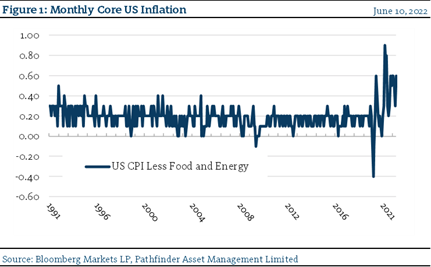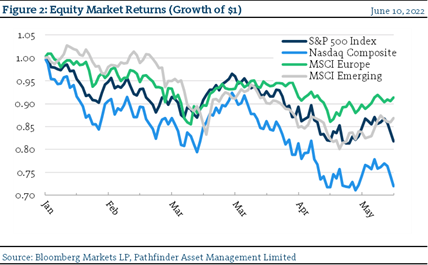CPI and a Bear Market
This morning, the US released inflation data that was not well received by the market. The US Consumer Price Index (CPI) has topped a 40-year high coming in at 8.6% for the year. While the number was not unexpected, what has spooked the market was the monthly rate of change in inflation, once food and energy costs have been removed. CPI is basically the change in prices of day-to-day goods. From the US Bureau of Labor and Statistics: “Prices are collected each month in 75 urban areas across the country from about 6,000 housing units and approximately 23,000 retail establishments (department stores, supermarkets, hospitals, filling stations, and other types of stores and service establishments)”. Food and Energy comprise just over 21.5% of the index and are quite volatile, so market participants often like to remove those components to get a cleaner view of broad inflation. Indeed, in the recent release, energy costs were up 34.6% and food was up 10.1% (year on year) while “All Other Items” were up 6.0%. Removing those volatile pieces can give us a different view of how inflation is creeping into other aspects of our lives, and it was this number that caused the markets to drop on the market open this morning.
Expectations were that month-on-month CPI (ex Food and Energy) would be the same or lower than last month, but it actually had gone higher. Markets immediately reacted and have priced in a more aggressive response from the US FOMC for next month’s meeting. Figure 1 presents monthly inflation over time and the recent acceleration is obvious.

The disappointing data has pushed the S&P 500 close to a top to bottom drop of -20%, which would label it a “bear” market. A number of markets are already there with NASDAQ through -20% last week and Italy crossing as well. Figure 2 presents a cross section of several markets for illustration.

“This means that” we should expect more volatility from financial markets as both central banks and investors work through higher inflation expectations. However, long-term investors can use this as an opportunity to position themselves in great quality companies. We have been quite active in adjusting the positioning in all of our mandates over the past several weeks.
National Instrument 31-103 requires registered firms to disclose information that a reasonable investor would expect to know, including any material conflicts with the firm or its representatives. Doug Johnson and/or Pathfinder Asset Management Limited are an insider of companies periodically mentioned in this report. Please visit www.paml.ca for full disclosures.
*All returns are time weighted and net of investment management fees. Returns from the Pathfinder Partners’ Fund and Partners’ Real Return Plus Fund are presented based on the masters series of each fund. The Pathfinder Core: Equity Portfolio and The Pathfinder Core: High Income Portfolio are live accounts. These are actual accounts owned by the Pathfinder Chairman (Equity) and client (High Income) which contain no legacy positions, cash flows or other Pathfinder investment mandates or products. Monthly inception dates for each fund and portfolio are as follows: Pathfinder Core: Equity Portfolio (January 2011), Pathfinder Core: High Income Portfolio (October 2012) Partners’ Fund (April 2011), Partners’ Real Return Plus Fund (April, 2013), and Partners’ Core Plus Fund (November 2014).
Pathfinder Asset Management Limited (PAML) and its affiliates may collectively beneficially own in excess of 10% of one or more classes of the issued and outstanding equity securities mentioned in this newsletter. This publication is intended only to convey information. It is not to be construed as an investment guide or as an offer or solicitation of an offer to buy or sell any of the securities mentioned in it. The author has taken all usual and reasonable precautions to determine that the information contained in this publication has been obtained from sources believed to be reliable and that the procedures used to summarize and analyze such information are based on approved practices and principles in the investment industry. However, the market forces underlying investment value are subject to sudden and dramatic changes and data availability varies from one moment to the next. Consequently, neither the author nor PAML can make any warranty as to the accuracy or completeness of information, analysis or views contained in this publication or their usefulness or suitability in any particular circumstance. You should not undertake any investment or portfolio assessment or other transaction on the basis of this publication, but should first consult your portfolio manager, who can assess all relevant particulars of any proposed investment or transaction. PAML and the author accept no liability of any kind whatsoever or any damages or losses incurred by you as a result of reliance upon or use of this publication.